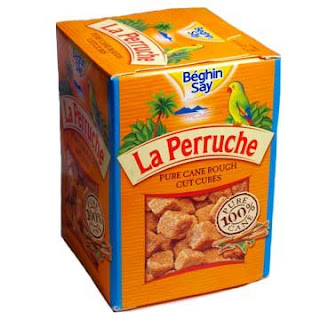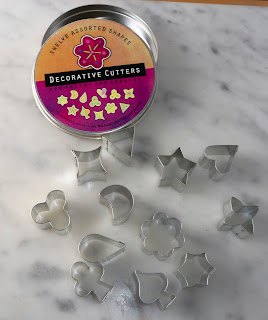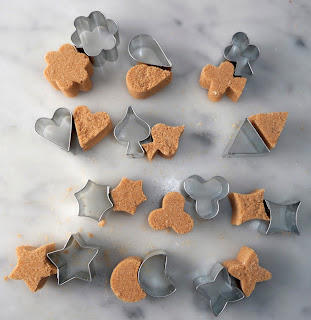It seems as though my baking life is filled with problem-solving – even when what I'm doing isn't actually baking in the strictest sense of the word. That being said, I wouldn't have it any other way because what I'm doing is so much fun!
That said, I had to solve the problem with what was rapidly becoming my latest obsession. I needed to put on the thinking cap; it was a little tight (so many good thoughts in there) but I managed to squeeze into it. This immediately dislodged the the idea of silicone molds from some dark recess of my mind. Perfect! Heat resistant. Flexible. Easy to use. And I could get several different shapes! And off I went mold shopping.
Four kitchen stores, and a deep Google search, later and all I could come up with was this:
Color me so confused! I thought for sure there would be tons of different shaped molds for this project. I mean, isn't this the age of technological wonders? Isn't this the era of modern synthetic materials manufacturing? Alas, not for my rather esoteric needs. The molds I found, even when looking on-line, were either too big, too impractical or too boring. I mean, who wants boring sugar shapes to put into their coffee? Still, the shell mold was a good start.
The problem I found with it was that the silicone was all wobbly when I pressed the sugar into it. Now a little wobble in a mold isn't a disaster but this thing flopped around like it was having a seizure! Whenever I loaded up one row and moved to the next, the previous row snapped up and flung the sugar out of it! Onto the table. And onto the floor. I didn't take me long to figure out that I needed a better process if I didn't want to be constantly sweeping up wasted sugar.
What I eventually came up with was spooning sugar into each section until I filled the mold. Next I covered the mold with plastic wrap and pressed evenly across the entire mold. Originally, I used waxed paper but the sugar stuck to it too much. Turns out the plastic wrap wasn't any better but I soldiered on. I removed any sugar that wasn't packed into the sections so I could reuse it in the next batch and popped it into the oven.
Figuring out the right temperature and time to bake the moisture out of it without setting it on fire, or causing the molasses content to darken at all, was of paramount importance because I can't stand the smell of burned sugar. Who does? I reasoned that towards the top-end of the range used to warm up leftovers was safe. 200° for twenty minutes would probably work best. Anything hotter than that would cook the sugar instead of dry it out.
Let's hear it for intuition (I've scorched enough desserts and dinners in the oven to have acquired a bit of that)! Because of the silicone, the shells popped right out with no problem at all. And there I had it – relatively simple, definitely cute, easy to use sugar shapes! There was much rejoicing in coffee land!
Until I discovered an evil little fact about brown sugar shapes: unless you keep them in an air-tight container, while your back is turned they will suck up every last bit of moisture in the air and go soft and mush together into a lump that will then harden up into an unusable mass. Why, oh why, must it mess with my mind in such ways?!? I invested in a few of the aforementioned containers and I was well on my way to enjoying being able to drop sweet little sea shells into my coffee. And yet...
And yet I still wanted a variety of shapes to have on hand. Again the thinking cap went on. Again it was a tight fit. Again an idea popped right out. I needed candy molds! That would give me access to lots of different shapes. And what was more, they should be antique metal molds so that they were easier to press sugar into the sections and be extremely heat resistant! Quick! To the Ebay Machine!
I set up and saved a search for "antique metal candy mold" and soon found and purchased this:
Since the metal mold isn't flexible, I have to tap it every so gently with a hammer to get the sugar to fall out. Obviously I don't do this a midnight, considering how bell-like the mold rings when I'm convincing it to let go of my cubes.
And now a word from our sponsor, Humility (a division of Crow Eating, Inc.)
At this juncture in my narration, I feel I must tell you of a humbling incident I had with a couple of these molds. The metal mold pictured above isn't actually the first one I bought. It's a replacement (same style) for the first one I bought. The first one I bought suffered a catastrophe caused by my own faulty reasoning. A couple of years ago, right before my birthday tea, I made sugar using two molds. Now, I usually wash the metal molds after I'm finished with them and pop them back in the oven for few minutes to dry them. They're old and prone to rust, so I don't let them air dry. I did that, turned off the oven but left the molds in. Michele came home later that night, and wanted to preheat the oven for her dinner. She noticed the molds and asked about them. "They're metal, so just go ahead," I replied.
Ten minutes later I decided to pull the molds out and cool them off before putting them away. I opened the oven door to see them starting to drip and pool all over the oven like a bad Dali painting! Oh. No! Not solid metal: solid frames with solid sections soldered together! I quickly removed the melting molds but the damage was already done. The inside of the oven was coated with puddled and splashed solder. I freaked like I never freaked before! I'd destroyed the oven! I'd destroyed my birthday tea plans! And I'd destroyed my wife's dinner!
To Michele's credit, she kept calm and in doing so calmed me down, too. Within minutes I was merely hyperventilating instead of having a coronary. We determined the best course of action was to find out how to remove the solder, determine if the oven was indeed destroyed, and figure out if I'd have to cancel my birthday tea because I'd need the oven to do all my baking for it. Interestingly enough, there wasn't anything on the Internet that could help me with the first of those, nor could anyone at any hardware store. And we didn't dare call the super just yet. All I could do was buy supplies that I thought might help: heavy gloves, paint scrapers, sand paper, blowtorch, dynamite and some pixie dust. Okay, those last three weren't really on my list but I was sure the first three would be just as effective and we'd end up buying a new oven. And I'd have to cancel my birthday tea.
The next evening after work I donned the heavy gloves, grabbed the paint scraper, opened the oven door and prepared to do battle with the consequences of my lack of foresight. Some of the solder had splashed onto the inside of the oven door and I decided to start there, applying the scraper to the hardened bead of metal. And it came right up with no effort at all. Not willing to believe what had just happened, I applied the scraper to a large-ish blotch nearby. It, too, came right up! I held it in my hand, a moment of time frozen in solidified, yet soft, metal and two realizations came into my head. First, solder works best on specific metals, and apparently the enameled steel of the oven didn't qualify. Second, the oven was...not quite clean, having experienced more than its fair share of my baking and cooking spillages. I had been meaning to clean it for some time now. The, um...residue of those mishaps had given the oven what amounted to a Teflon coating of sorts. all of the solder, even what had gotten on the racks, just came right up when I applied a little pressure to the scraping! Saved by laziness!
It didn't take long for me to have the oven cleaned and ready for baking. The birthday tea could go on! We didn't have to buy a new oven! My heart stopped aging faster than the rest of my body! Unfortunately, Michele's ruined dinner would never be reclaimed. About this I am still very, very sorry.
The moral of the story: Always make sure you know what the hell your sugar molds are made of. Oh, and don't be so diligent about cleaning your oven!
Word from our sponsor ends.
I've procured several great molds on E-bay and I'll post pictures of them from time to time here. Also, Michele bought me some very cool high-temperature plastic molds that I use from time to time and I'll post images of those as well.
If you get the urge to make your own cubes, let me know what you use and what your process is! I'll be happy to answer any questions you might have or learn any nuances you come up with!
Currently listening to: "Glide" by Pleasure
That said, I had to solve the problem with what was rapidly becoming my latest obsession. I needed to put on the thinking cap; it was a little tight (so many good thoughts in there) but I managed to squeeze into it. This immediately dislodged the the idea of silicone molds from some dark recess of my mind. Perfect! Heat resistant. Flexible. Easy to use. And I could get several different shapes! And off I went mold shopping.
Four kitchen stores, and a deep Google search, later and all I could come up with was this:
| It's a shell game. |
The problem I found with it was that the silicone was all wobbly when I pressed the sugar into it. Now a little wobble in a mold isn't a disaster but this thing flopped around like it was having a seizure! Whenever I loaded up one row and moved to the next, the previous row snapped up and flung the sugar out of it! Onto the table. And onto the floor. I didn't take me long to figure out that I needed a better process if I didn't want to be constantly sweeping up wasted sugar.
What I eventually came up with was spooning sugar into each section until I filled the mold. Next I covered the mold with plastic wrap and pressed evenly across the entire mold. Originally, I used waxed paper but the sugar stuck to it too much. Turns out the plastic wrap wasn't any better but I soldiered on. I removed any sugar that wasn't packed into the sections so I could reuse it in the next batch and popped it into the oven.
| Spoon it in, pack it down, scrape it off, bake it up. |
| Sea shell sugar shapes. |
Until I discovered an evil little fact about brown sugar shapes: unless you keep them in an air-tight container, while your back is turned they will suck up every last bit of moisture in the air and go soft and mush together into a lump that will then harden up into an unusable mass. Why, oh why, must it mess with my mind in such ways?!? I invested in a few of the aforementioned containers and I was well on my way to enjoying being able to drop sweet little sea shells into my coffee. And yet...
And yet I still wanted a variety of shapes to have on hand. Again the thinking cap went on. Again it was a tight fit. Again an idea popped right out. I needed candy molds! That would give me access to lots of different shapes. And what was more, they should be antique metal molds so that they were easier to press sugar into the sections and be extremely heat resistant! Quick! To the Ebay Machine!
I set up and saved a search for "antique metal candy mold" and soon found and purchased this:
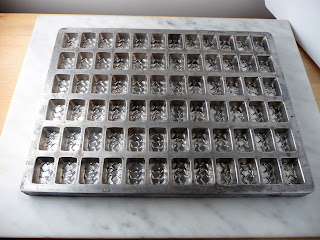 |
| Old mold gold! |
This is a mold made in the 30s, I believe, and it's actually for chocolates. It's sturdy, heavy and takes the sugar quite nicely. With shipping, it cost under $30 and therefore fit my budget quite nicely. And it's pretty! The same process worked for the metal as did for the silicone, with one alteration. I kept trying to figure out how to press the sugar into the molds without getting sugar stuck to my hands. The wax paper, the plastic wrap, the rubber gloves I purchased (one set specifically made for candy handling) all ended up caked with sugar. I puzzled and puzzled without coming up with a solution to this particularly annoying problem. Upon seeing the smoke drifting out of my ears, Michele asked me why I didn't just use the plastic that the sugar comes packaged in. Use. The. Sugar. Plastic! A Gru-type moment of clarity washed over me! Thus was born the process I now use to great success with every batch of sugar I make.
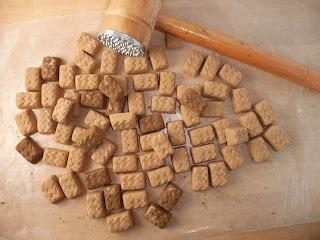 |
| Hammered into shape. |
And now a word from our sponsor, Humility (a division of Crow Eating, Inc.)
At this juncture in my narration, I feel I must tell you of a humbling incident I had with a couple of these molds. The metal mold pictured above isn't actually the first one I bought. It's a replacement (same style) for the first one I bought. The first one I bought suffered a catastrophe caused by my own faulty reasoning. A couple of years ago, right before my birthday tea, I made sugar using two molds. Now, I usually wash the metal molds after I'm finished with them and pop them back in the oven for few minutes to dry them. They're old and prone to rust, so I don't let them air dry. I did that, turned off the oven but left the molds in. Michele came home later that night, and wanted to preheat the oven for her dinner. She noticed the molds and asked about them. "They're metal, so just go ahead," I replied.
Ten minutes later I decided to pull the molds out and cool them off before putting them away. I opened the oven door to see them starting to drip and pool all over the oven like a bad Dali painting! Oh. No! Not solid metal: solid frames with solid sections soldered together! I quickly removed the melting molds but the damage was already done. The inside of the oven was coated with puddled and splashed solder. I freaked like I never freaked before! I'd destroyed the oven! I'd destroyed my birthday tea plans! And I'd destroyed my wife's dinner!
To Michele's credit, she kept calm and in doing so calmed me down, too. Within minutes I was merely hyperventilating instead of having a coronary. We determined the best course of action was to find out how to remove the solder, determine if the oven was indeed destroyed, and figure out if I'd have to cancel my birthday tea because I'd need the oven to do all my baking for it. Interestingly enough, there wasn't anything on the Internet that could help me with the first of those, nor could anyone at any hardware store. And we didn't dare call the super just yet. All I could do was buy supplies that I thought might help: heavy gloves, paint scrapers, sand paper, blowtorch, dynamite and some pixie dust. Okay, those last three weren't really on my list but I was sure the first three would be just as effective and we'd end up buying a new oven. And I'd have to cancel my birthday tea.
The next evening after work I donned the heavy gloves, grabbed the paint scraper, opened the oven door and prepared to do battle with the consequences of my lack of foresight. Some of the solder had splashed onto the inside of the oven door and I decided to start there, applying the scraper to the hardened bead of metal. And it came right up with no effort at all. Not willing to believe what had just happened, I applied the scraper to a large-ish blotch nearby. It, too, came right up! I held it in my hand, a moment of time frozen in solidified, yet soft, metal and two realizations came into my head. First, solder works best on specific metals, and apparently the enameled steel of the oven didn't qualify. Second, the oven was...not quite clean, having experienced more than its fair share of my baking and cooking spillages. I had been meaning to clean it for some time now. The, um...residue of those mishaps had given the oven what amounted to a Teflon coating of sorts. all of the solder, even what had gotten on the racks, just came right up when I applied a little pressure to the scraping! Saved by laziness!
It didn't take long for me to have the oven cleaned and ready for baking. The birthday tea could go on! We didn't have to buy a new oven! My heart stopped aging faster than the rest of my body! Unfortunately, Michele's ruined dinner would never be reclaimed. About this I am still very, very sorry.
The moral of the story: Always make sure you know what the hell your sugar molds are made of. Oh, and don't be so diligent about cleaning your oven!
Word from our sponsor ends.
I've procured several great molds on E-bay and I'll post pictures of them from time to time here. Also, Michele bought me some very cool high-temperature plastic molds that I use from time to time and I'll post images of those as well.
If you get the urge to make your own cubes, let me know what you use and what your process is! I'll be happy to answer any questions you might have or learn any nuances you come up with!
Currently listening to: "Glide" by Pleasure














